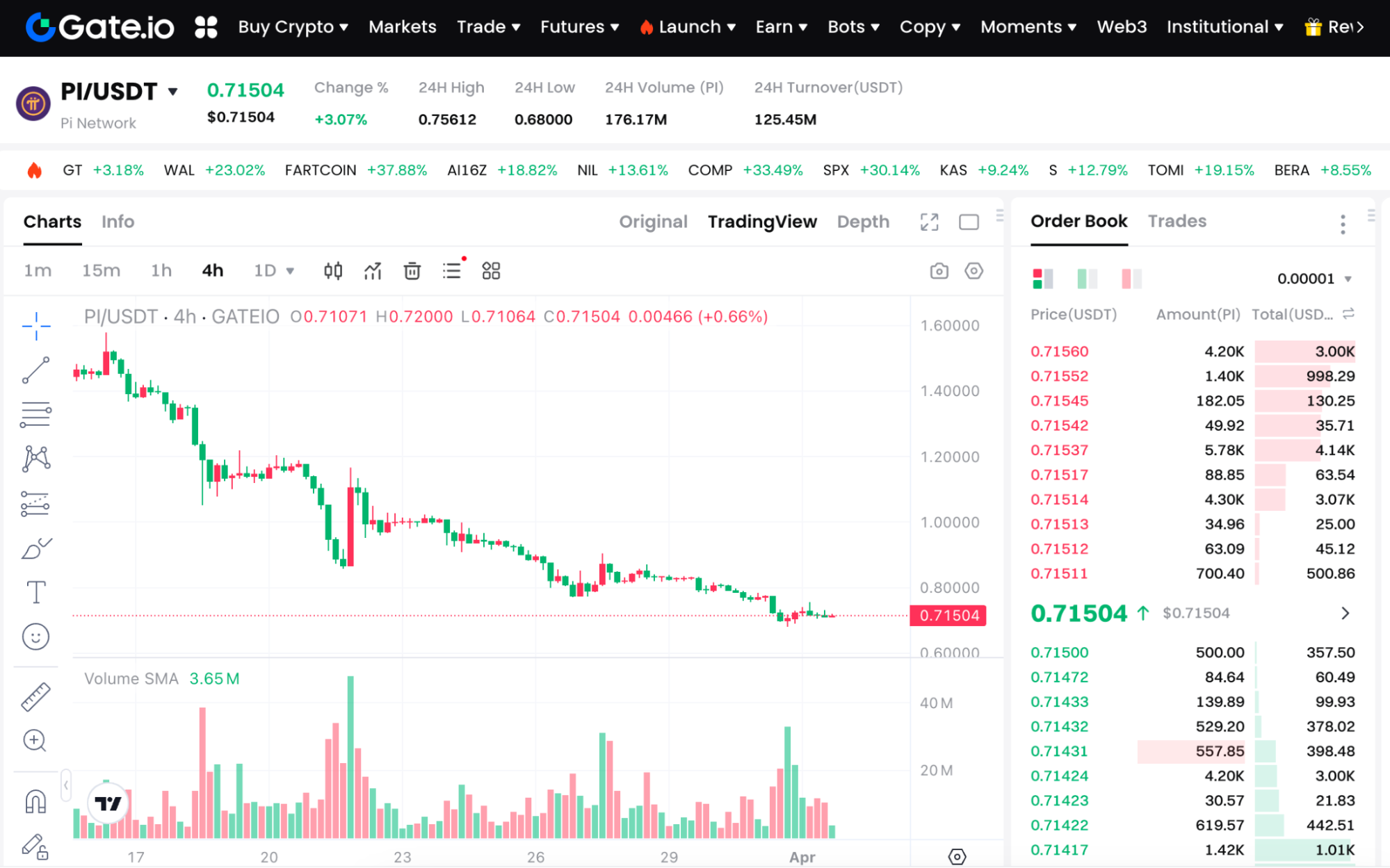Оновлення новин про основну мережу Pi Coin: Огляд можливостей та викликів
1. Вступ
У сучасній цифровій епоці криптовалюта, як нова фінансова актив, поступово змінює глобальний фінансовий пейзаж. Pi Coin, як основна криптовалюта проекту Pi Network, здобула багато уваги в галузі криптовалют з моменту свого створення завдяки своєму унікальному механізму видобутку та широкій користувацькій базі. Pi Network має на меті побудувати децентралізовану екосистему цифрової валюти, в якій може брати участь кожен, і залучила велику кількість користувачів по всьому світу, знизивши бар'єр для участі користувачів у галузі криптовалют через мобільний майнінг.
Динаміка розвитку головної мережі Pi Coin має значний вплив на весь ринок криптовалют. Запуск головної мережі є ключовою віхою в розвитку Pi Coin, що позначає його перехід з фази тестування на офіційну експлуатацію з більшими функціями та використанням. Це не тільки надає більше прав та можливостей власникам Pi Coin, але й впроваджує нову життєву силу на ринок криптовалют. У той же час, розвиток головної мережі Pi Coin також стикається з багатьма викликами, такими як технічна стабільність, ринкова прийнятність, регулятивні політики і т. д., що безпосередньо впливає на його майбутні перспективи розвитку.

Увійдіть на торгову платформу Gate.com, щоб торгувати токенами PI: https://www.Gate.com/trade/PI_USDT
2. Огляд проекту Pi Coin Основна мережа
2.1 Походження та історія розвитку монети Pi
Походження монети Pi можна відслідкувати до 14 березня 2019 року, коли група дослідників та інженерів з університету Стенфорда заснувала її. Вони мали на меті створити криптовалюту, в якій міг би брати участь кожен, щоб вирішити проблеми, такі як високий поріг і енергоспоживання традиційного майнінгу криптовалют. Проект Pi Network народився з основною метою надання можливості користувачам по всьому світу легко брати участь у майнінгу криптовалюти через мобільні пристрої, досягаючи візії фінансової інклюзії та децентралізації.
На початкових етапах проекту Pi Coin переважно привертав користувачів за допомогою механізму запрошення. Користувачі можуть збільшити швидкість видобутку, запрошуючи друзів приєднатися до мережі Pi, і цей соціальний вірусний метод просування призвів до стрімкого зростання кількості користувачів Pi Coin. Від початкової участі декількох ентузіастів до поступового привертання глобальної уваги, Pi Coin накопичив велику користувацьку базу всього за кілька років.
Зі зростанням кількості користувачів Pi Coin почав входити в фазу тестування. Протягом періоду тестування розробницька команда провела комплексне тестування різних функцій Pi Coin, включаючи продуктивність блокчейну, швидкість обробки транзакцій, безпеку та інше. Через постійне тестування та оптимізацію було вирішено багато потенційних технічних проблем, готуючи до офіційного запуску на Основній мережі. У той же час тестова мережа також привернула численних розробників до участі, які створили різноманітні застосунки на основі тестової мережі Pi Coin, лягаючи фундамент для майбутнього розвитку екосистеми.
20 лютого 2025 року монета Pi офіційно запустила свою Основну мережу, що є важливим віхолем у розвитку монети Pi. Запуск Основної мережі свідчить про перехід монети Pi з фази тестування до фази практичного застосування, де користувачі можуть проводити реальні транзакції в Основній мережі та реалізувати переказ цифрової валюти. Ця подія привернула широку увагу в галузі блокчейну та криптовалюти, приносячи більше можливостей та викликів для майбутнього розвитку монети Pi.
Аналіз технічних характеристик мережі 2.2 Pi Coin Основна мережа
Мережа Pi Coin має багато унікальних технічних аспектів, які відрізняють її від багатьох криптовалют.
Pi Coin використовує протокол Stellar Consensus Protocol (SCP), який є інноваційним алгоритмом консенсусу. У порівнянні з традиційним механізмом Proof of Work (PoW), SCP має значні переваги. PoW вимагає великої кількості обчислювальних ресурсів та енергоспоживання для вирішення складних математичних завдань для перевірки транзакцій та створення нових блоків, що призводить до втрати енергії та високих вхідних бар'єрів. На противагу цьому, SCP досягає консенсусу між вузлами шляхом створення розподіленого графіка довіри, усуваючи потребу в обширних обчисленнях, таким чином значно зменшуючи споживання енергії та підвищуючи ефективність транзакцій. Крім того, SCP демонструє хорошу масштабованість для задоволення потреб великомасштабних користувачів і транзакцій, забезпечуючи безпеку та ефективність мережі.
Спосіб видобутку монети Pi також унікальний, оскільки він дозволяє користувачам видобувати за допомогою мобільних пристроїв. Користувачам просто потрібно завантажити програму Pi Network та клацнути кнопку один раз на день, щоб завершити видобуток, без необхідності високопродуктивного обладнання чи великої кількості споживаної електроенергії. Цей метод низького порогу дозволяє більшій кількості людей брати участь у видобутку криптовалют, досягаючи популяризації криптовалют. Крім того, швидкість видобутку монети Pi буде поступово зменшуватися з ростом мережі та використовує механізм подвоєння для контролю постачання валюти, забезпечуючи стійкість системи та мотивуючи ранніх учасників.
Що стосується механізмів безпеки, Pi Coin побудував багаторівневу систему безпеки. З одного боку, за допомогою механізму кола безпеки користувачі можуть запросити своїх довірених контактів приєднатися до кола безпеки, при цьому кожен учасник може додати до п'яти довірених осіб, утворюючи систему безпеки, засновану на довірі. Такий децентралізований підхід забезпечує безпеку перевірки транзакцій без необхідності централізованого контролю. З іншого боку, основна мережа Pi Coin використовує передову технологію шифрування для шифрування даних транзакцій та особистої інформації користувачів, запобігаючи витоку даних і фальсифікації, забезпечуючи безпеку та конфіденційність активів користувачів.
Порівняно з іншими криптовалютами, низький поріг входу та широка користувацька база Pi Coin є його значними конкурентними перевагами. Для видобутку основних криптовалют, таких як Біткоїн, потрібні професійні гірничі машини та велика кількість енергії, що ускладнює участь звичайних користувачів. Однак Pi Coin дозволяє більшій кількості людей легко увійти в галузь криптовалют, видобуваючи через мобільні пристрої, зменшуючи витрати на навчання для нових користувачів. Крім того, Pi Coin постійно прагне до технологічних інновацій, а його унікальний механізм згоди та механізми безпеки закладають міцний фундамент для його майбутнього розвитку.
2.3 Огляд дорожньої карти розвитку основної мережі Pi Coin
Розробка основної мережі Pi Coin відбувається відповідно до уважно спланованої дорожньої карти, з чітко визначеними цілями для кожної фази, які відіграли важливу керівну роль у зростанні проекту.
На початкових етапах Pi Coin встановив ціль побудувати велику базу користувачів. Завдяки інноваційному механізму запрошення та стратегії вірусного маркетингу він привернув велику кількість користувачів. Концом 2021 року база користувачів Pi Coin досягла десятків мільйонів, ставши одним з найвидатніших проектів у криптовалютному просторі.
Монета Pi потім увійшла в фазу тестування, де головною метою було проведення технічних випробувань та оптимізація. Командa розробників докладно тестувала ключові метрики, такі як продуктивність блокчейну, швидкість обробки транзакцій та безпека, постійно виявляючи та вирішуючи проблеми для забезпечення стабільності та надійності основної мережі. Протягом періоду тестування, розробники активно взаємодіяли з членами спільноти, збирали відгуки та здійснювали постійні вдосконалення. Багато розробників створили програми на основі тестової мережі, збагачуючи екосистему монети Pi та готуючись до остаточного запуску основної мережі.
20 лютого 2025 року Pi Coin успішно запустив свою основну мережу, що є важливим кроком у розвитку дорожньої карти. Запуск основної мережі дозволив реальні транзакції та передачу вартості, переходячи Pi Coin з концептуальної фази до практичного застосування. У той же час запуск основної мережі надав більше можливостей для побудови екосистеми, привертаючи більше розробників та бізнесів для приєднання до екосистеми Pi Coin.
Придивляючись до стану завершення, Pi Coin зробив значний прогрес на кожній фазі. Зріст користувачів перевищив очікування, технічна оптимізація тестової мережі пройшла успішно, а запуск основної мережі заклав міцний фундамент. Після запуску основної мережі, незважаючи на виклики, такі як коливання на ринку та потребу подальшого визнання користувачів, загальний тренд розвитку лишається позитивним.
Дорожню карту розвитку монети Pi тісно пов'язано між собою, причому цілі кожної фази підтримують розвиток наступної фази. Накопичення ранньої користувацької бази підтримувало розвиток тестової та основної мережі, технічна оптимізація тестової мережі забезпечила стабільність основної мережі, а запуск основної мережі відкрив двері для побудови екосистеми та довгострокового зростання.

3. Останні оновлення Основної мережі монети Pi
3.1 Останній технічний прогрес та оптимізація Основна мережа
Щодо технологічного прогресу, Основна мережа Pi Coin продовжує робити прориви. Оптимізація продуктивності Основної мережі є одним з останніх ключових аспектів, і команда розробників значно покращила швидкість обробки транзакцій, оптимізувавши основну архітектуру блокчейну. У найновіших тестах час підтвердження транзакцій Основної мережі Pi Coin був скорочений з середніх 30 секунд до 15 секунд, що дозволяє користувачам отримувати підтвердження швидше при здійсненні транзакцій, що значно підвищує ефективність транзакцій. В той же час, пропускна здатність мережі також була значно збільшена, що підтримує більше одночасних транзакцій для задоволення зростаючого попиту користувачів.
Основна мережа Pi Coin зробила значний прогрес у плані функціональних оновлень. Введення функціональності смарт-контрактів надає розробникам ширший простір для інновацій. Розробники можуть створювати різноманітні децентралізовані додатки (DApps) на основі основної мережі Pi Coin, такі як додатки для децентралізованої фінансової сфери (DeFi), ринки не змінних токенів (NFT) тощо. Впровадження смарт-контрактів робить екосистему основної мережі Pi Coin більш багатою та різноманітною, привертаючи більше розробників та користувачів для участі. Крім того, Основна мережа також посилила підтримку захисту конфіденційності, використовуючи передову технологію доказів з нульовим відомості, щоб забезпечити повний захист інформації про транзакції користувача та особистої конфіденційності.
Ці технологічні досягнення та оптимізації мали позитивний вплив на стабільність мережі та користувацький досвід. Швидші швидкості обробки транзакцій та вища пропускна здатність мережі дозволяють Основній мережі краще впоратися з одночасним доступом великої кількості користувачів, зменшуючи затори та затримки транзакцій, покращуючи стабільність мережі. Функціональність смарт-контрактів та підтримка конфіденційності забезпечують користувачів більшими можливостями та кращим користувацьким досвідом, підвищуючи довіру користувачів та задоволення від Основної мережі.
3.2 Екологічне будівництво та розширення сценаріїв застосування
Мережа Pi Coin досягла плідних результатів у екологічній конструкції, а сценарії використання продовжують розширюватися. У сфері децентралізованих фінансів (DeFi) з'явилися платформи кредитування та торгівлі, які базуються на основі мережі Pi Coin. Ці платформи надають користувачам зручні послуги кредитування та торгівлі, дозволяючи користувачам заставляти Pi Coin для отримання кредитів на платформі або проводити операції з Pi Coin з іншими криптовалютами. Наприклад, платформа кредитування Pi дозволяє користувачам позичати кошти під низькі відсоткові ставки, надаючи стабільний прибуток кредиторам, що привертає велику кількість користувачів для участі.
У сфері невзаємозамінних токенів (NFT) відбулися нові прориви в основній мережі Pi Coin. Деякі художники та творці почали випускати власні NFT-роботи в основній мережі Pi Coin, які мають унікальну художню та колекційну цінність. Через NFT-маркетплейс основної мережі Pi Coin користувачі можуть легко купувати, продавати та колекціонувати ці NFT-роботи, сприяючи розвитку та поширенню цифрового мистецтва. Крім того, основна мережа Pi Coin також досліджувала та застосовувала в таких сферах, як транскордонні платежі та фінансування ланцюга поставок, співпрацюючи з деякими підприємствами для реалізації пілотних проектів, досягаючи хороших результатів.
Pi Coin Mainnet активно встановлює партнерські відносини з іншими проєктами та установами. Він уклав партнерські угоди з декількома компаніями з блокчейн-технологіями для просування інновацій та застосування блокчейн-технологій. Співпраця з деякими фінансовими установами для дослідження сценаріїв застосування Pi Coin в традиційній фінансовій сфері, таких як розрахунково-платіжні операції, управління активами тощо. Ці партнерства не лише приносять більше ресурсів та технічної підтримки Pi Coin Mainnet, але й допомагають розширювати його сценарії застосування та підвищувати його вплив на ринку.
Розширення конструкції екосистеми та сценаріїв застосування відіграють важливу роль у довгостроковому розвитку Основної мережі монети Pi. Різноманітність сценаріїв застосування може привернути більше користувачів та розробників до участі в екосистемі Основної мережі, збільшуючи попит на монету Pi та її вартість. Укладення партнерських угод може забезпечити більше можливостей розвитку та ресурсів для Основної мережі монети Pi, сприяючи її технологічній інновації та розширенню бізнесу, тим самим підтримуючи постійне зростання та розширення Основної мережі монети Pi на ринку криптовалют.
3.3 Зміни в розвитку спільноти та залученні користувачів
Активність спільноти також значно зросла. Обговорення та обміни користувачів у спільноті стають все частішими, і неперервно проводяться різноманітні онлайн- та офлайн-активності. На офіційних форумах та групах у соцмережах користувачі активно діляться своїм досвідом використання, власними думками про проект та надають рекомендації, формуючи сприятливу атмосферу спільноти. У той же час спільнота також організувала різноманітні технічні обмінні активності, конкурси розробників та інше, привертаючи численних користувачів до участі, подальше стимулюючи життєвість спільноти.
Роль спільноти у просуванні проекту Pi Coin Mainnet не може бути ігнорована. Члени спільноти - це не тільки користувачі Pi Coin, але й просувальники та будівничі проекту. Вони привертають більше людей до вивчення та участі в проекті Pi Coin Mainnet за допомогою вуст в уста, просування у соціальних мережах та інших засобів. Члени спільноти також активно беруть участь у тестуванні та надсилають зворотний зв'язок щодо проекту, надаючи цінні думки та пропозиції для його поліпшення та оптимізації. Щодо розвитку екосистеми, розробники спільноти побудували багато додатків та сервісів на основі Pi Coin Mainnet, збагачуючи екосистему Основної мережі та просуваючи розвиток проекту.
3.4 Аналіз ринкової продуктивності та тенденції цін
Ринкова динаміка Pi Coin після запуску Основної мережі привернула багато уваги. Щодо цінових тенденцій, ціна Pi Coin відчула деякі коливання. На початкових етапах лістингу, через велику увагу ринку та ентузіазм інвесторів, ціна Pi Coin одного разу стрімко зросла до позначки в $2.8. Однак з поступовим заспокоєнням ринкового настрою та початковим продажем ранніх майнерів, ціна відчула значне зниження, опустившись до мінімуму у $0.7. Подальше з саморегулюванням ринку та впливом деяких позитивних факторів ціна почала стабілізуватись і почала зростати, наразі стабільно утримується на рівні близько $0.714.
Існує багато факторів, які впливають на коливання ціни Pi Coin. Ринкове співвідношення попиту і пропозиції є вирішальним фактором, що безпосередньо впливає на ціну. Ранній великомасштабний продаж майнерами збільшив пропозицію на ринку, що призвело до зниження ціни; у міру того, як ринковий попит на Pi Coin поступово зростав, ціна знову почала зростати. Настрої ринку та очікування інвесторів також суттєво впливають на ціни. На ранніх стадіях проекту інвестори були сповнені очікувань щодо майбутнього розвитку Pi Coin, що підвищило ринкові настрої та підштовхнуло ціни вище; Коли на ринку з'являються якісь негативні новини або зміни в очікуваннях інвесторів, настрої ринку знижуються, ціни також пригнічуються. Крім того, макроекономічне середовище, загальні тенденції на ринку криптовалют, а також технічний прогрес та екологічне будівництво проекту також матимуть непрямий або прямий вплив на ціну Pi Coin.
4. Виклики та проблеми, з якими стикається Основна мережа монети Pi
4.1 Технічні виклики та стратегії реагування
Мережа Pi Coin стикається зі серією серйозних викликів на технічному рівні, які є вирішальними для її довгострокового стабільного розвитку.
Масштабованість є однією з ключових проблем, яку необхідно терміново вирішити основній мережі Pi Coin. У зв'язку з постійним зростанням бази користувачів і розширенням масштабу транзакцій основна мережа повинна мати потужні можливості обробки для забезпечення ефективного виконання транзакцій і стабільної роботи мережі. На поточному етапі, незважаючи на те, що основна мережа Pi Coin прийняла деякі технічні засоби для підвищення продуктивності, вона все ще стикається зі значним тиском у масштабованості в умовах зростаючого попиту користувачів. Коли велика кількість користувачів проводить транзакції одночасно, можуть виникати перевантаження та затримки, що не тільки впливає на користувацький досвід, але й може знизити привабливість та конкурентоспроможність основної мережі.
Безпека є також важливим викликом, який не можна ігнорувати на Основній мережі Pi Coin. У сфері криптовалют завжди була головною метою для хакерських атак, і Основна мережа Pi Coin також стикається з ризиком атаки. Якщо виникає уразливість безпеки, безпека активів користувачів буде серйозно під загрозою, що може призвести до зменшення довіри користувачів та мати негативний вплив на розвиток проекту. Ризики безпеки, такі як рибальство та уразливості смарт-контрактів, завжди існують, що потребує від команди проекту посилення заходів безпеки для забезпечення безпеки коштів користувачів та конфіденційності особистої інформації.
Щоб вирішити ці технічні проблеми, команда проекту Pi Coin прийняла ряд проактивних та ефективних стратегій. З точки зору масштабованості, команда збільшила свої інвестиції в дослідження та розробки в базову технологію блокчейну, постійно оптимізуючи архітектуру мережі та алгоритми консенсусу. Впроваджуючи технологію шардингу, мережа блокчейн розбивається на кілька шардів, кожен шард може самостійно обробляти транзакції, тим самим збільшуючи пропускну здатність і обчислювальну потужність всієї мережі. У той же час команда також вивчає використання технології сайдчейнів для передачі деяких транзакцій у сайдчейни для обробки, зменшуючи навантаження на основну мережу та ще більше підвищуючи масштабованість.
З питань безпеки команда проекту Pi Coin встановила суворий механізм перевірки безпеки, регулярно проводить перевірки безпеки та пошуку вразливостей на Основній мережі, швидко виявляє та усуває потенційні проблеми з безпекою. Посилені перевірки безпеки розумних контрактів для забезпечення коректності та безпеки коду контракту, запобігання інцидентів з безпекою, спричинених вразливостями розумних контрактів. Крім того, команда активно співпрацює з професійними агентствами з безпеки для спільного вирішення загроз мережевої безпеки та підвищення загальних можливостей захисту безпеки Основної мережі.
4.2 Регуляторні ризики та питання відповідності
На глобальному рівні мережа Pi Coin Основна мережа стикається з складним і постійно змінюючимся регуляторним середовищем, яке призводить до багатьох невизначеностей у розвитку проекту.
Існують значні різниці в регуляторній політиці стосовно криптовалют в різних країнах та регіонах. Деякі країни мають відкрите та підтримуюче ставлення до криптовалют, активно сприяючи розвитку та застосуванню криптовалют, забезпечуючи відносно спокійне середовище для розвитку Основної мережі Pi Coin. Однак багато країн прийняли обережні або навіть строгі регуляторні заходи щодо криптовалют. Деякі країни вважають криптовалюту незаконними фінансовими інструментами, забороняючи їх торгівлю та обіг, тоді як інші накладають строгі обмеження на криптовалютні біржі, вимагаючи дотримання таких правил, як протидія відмиванню грошей, боротьба з фінансуванням тероризму, проведення суворої перевірки особистості користувача та перевірки джерела коштів.
Відмінності та зміни в регуляторній політиці мали багатогранний вплив на розвиток основної мережі Pi Coin. Невизначеність регуляторної політики підвищила операційні ризики проекту. При виході на світовий ринок основна мережа Pi Coin повинна постійно адаптуватися до нормативних вимог різних країн і регіонів, що може призвести до збільшення операційних витрат і уповільнення розвитку. Сувора регуляторна політика може обмежити сценарії застосування та просування Pi Coin на ринку. У деяких областях із суворими правилами Pi Coin може не широко використовуватися в певних сферах, що впливає на його частку ринку та базу користувачів. Зміни в регуляторній політиці також можуть спричинити коливання ринку, що призведе до значних коливань цін на Pi Coin і вплине на довіру інвесторів.
Для подолання регуляторних ризиків команда проекту Pi Coin активно спілкується та співпрацює з регуляторними органами, проактивно розуміє та виконує відповідні правила. Команда створила відділ відповідності, який відповідає за відстеження та дослідження регуляторних політик у різних країнах світу та формулювання відповідних стратегій відповідності. Під час роботи над проектом строге дотримання правил протидії відмиванню грошей, протидії фінансуванню тероризму, посилення перевірки ідентичності користувачів та перегляд джерел фінансування, забезпечуючи відповідну роботу проекту. У той же час команда активно бере участь у формулюванні стандартів галузі, сприяючи здоровому розвитку індустрії криптовалют та прагненню отримати більше підтримки та визнання в регуляторному середовищі.
4.3 Конкуренція на ринку та виклики довіри користувачів
На конкурентному ринку криптовалют Pi Coin Mainnet стикається з викликами від багатьох конкурентів.
Основні криптовалюти, такі як Bitcoin та Ethereum, займають велику частку ринку завдяки своєму першопрохідному переваги і сильному впливу бренду. Вони мають зрілі технічні системи, широкі сценарії застосування та велику базу користувачів, що робить їх перевідним вибором для інвесторів та користувачів. Інші нові проекти криптовалют постійно з'являються, намагаючись вирізати свою частку на ринку через інноваційну технологію та унікальні сценарії застосування. Ці конкуренти мають певні переваги в технологічній інновації, ринковому просуванні, користувацькому досвіді та іншому, надаючи великий тиск на розвиток Основної мережі Pi Coin.
Довіра користувачів - один з ключових факторів розвитку основної мережі Pi Coin, проте наразі основна мережа Pi Coin все ще зіштовхується з деякими викликами у сфері довіри користувачів. У зв'язку з складністю та невизначеністю ринку криптовалют, деякі користувачі сумніваються у автентичності та надійності основної мережі Pi Coin. Деякі користувачі хвилюються щодо того, чи зможе основна мережа Pi Coin дійсно досягти заявлених цілей, і чи існують технічні ризики та проблеми з безпекою. Також основна мережа Pi Coin зіткнулася з деякими проблемами у процесі розробки, такими як затримки у запуску основної мережі, що може призвести до зниження довіри деяких користувачів до проекту.
Для того, щоб підвищити довіру користувачів, команда проекту Pi Coin вжила ряд заходів. Вони підвищили прозорість проекту, регулярно розкриваючи користувачам хід проекту та технічні деталі, що дозволяє їм краще зрозуміти динаміку розвитку проекту. Через офіційний веб-сайт, соціальні мережі та інші канали вони оперативно відповідають на запитання користувачів і вирішують їхні проблеми. У той же час команда активно демонструє технічну міць проекту і досягнення в області застосування, доводячи надійність і практичність основної мережі Pi Coin на практичних кейсах. Вони також зміцнили побудову спільноти, заохочуючи користувачів брати участь в обговореннях проєктів і прийнятті рішень, покращуючи відчуття приналежності та ідентифікації користувачів, а також підвищуючи довіру користувачів до проєкту завдяки силі спільноти.
5. Прогноз майбутніх тенденцій розвитку та перспектив
5.1 Pi Coin Основна мережа Перспективи майбутнього розвитку
З технічної точки зору, Pi Coin Mainnet очікується продовжувати інновації в майбутньому. З розвитком технології блокчейну Pi Coin може подальше оптимізувати свій алгоритм консенсусу, покращити мережеву продуктивність та безпеку. Наприклад, вдосконалення Протоколу консенсусу Stellar (SCP), щоб краще задовольняти потреби великих користувачів та транзакцій, збільшення швидкості обробки транзакцій та пропускної здатності мережі. Pi Coin може посилити дослідження та застосування технологій захисту конфіденційності, використовуючи більш продуктивні алгоритми шифрування та технологію доказу нуль-знань для забезпечення повного захисту інформації про транзакції користувачів та особистої конфіденційності, зміцнюючи довіру користувачів до Основної мережі.
З точки зору екологічного будівництва, сценарії застосування Pi Coin в основній мережі будуть продовжувати розширюватися. На додаток до існуючих сфер децентралізованих фінансів (DeFi) і невзаємозамінних токенів (NFT), Pi Coin може застосовуватися в більшій кількості областей. У сфері Інтернету речей Pi Coin може служити середовищем для обміну цінностями між пристроями, реалізуючи децентралізоване управління та обмін даними пристроїв IoT. У сфері фінансування ланцюга поставок Pi Coin може використовувати незмінність блокчейну для досягнення прозорості та відстеження інформації про ланцюжок поставок, тим самим підвищуючи ефективність та безпеку фінансування ланцюга поставок. Pi Coin також може інтегруватися з більш традиційними галузями, такими як електронна комерція, охорона здоров'я та освіта, надаючи цим галузям нові можливості для розвитку.
Щодо ринку, очікується, що користувацька база основної мережі Pi Coin продовжить розширюватися. Зі зростанням популярності Pi Coin та постійним розширенням його сценаріїв застосування, до екосистеми Pi Coin можуть бути привернуті все більше користувачів. Pi Coin також може привернути більше інституційних інвесторів для участі, а вхід інституційних інвесторів принесе більше коштів та ресурсів Pi Coin, підвищивши його вплив на ринок. Глобальна ринкова стратегія Pi Coin також продовжить розвиватися, особливо на ринках розвиваючихся країн, де Pi Coin може отримати більшу визнаність та підтримку від користувачів завдяки своєму низькому порогу входу та інноваційним ідеям.
5.2 Прогноз цін та аналіз інвестиційних перспектив
Прогнозування майбутньої ціни Pi Coin є складним завданням, оскільки на ринок криптовалют впливають різні складні фактори. З точки зору ринкового попиту та пропозиції, якщо сценарії застосування Pi Coin продовжуватимуть розширюватися, попит користувачів продовжуватиме зростати, а пропозиція залишатиметься відносно стабільною, то очікується, що ціна Pi Coin зросте. Оскільки все більше і більше продавців приймають Pi Coin як спосіб оплати, попит на Pi Coin зростатиме, що призведе до зростання ціни. Якщо на ринку є великий обсяг продажів, що призводить до значного збільшення пропозиції без відповідного зростання попиту, то ціна Pi Coin може впасти.
Настрій ринку та очікування інвесторів також мають значний вплив на ціну монети Pi. Якщо ринок впевнений у майбутньому розвитку монети Pi і інвестори очікують подальшого зростання її вартості, то настрій ринку буде підштовхувати ціни вгору. Навпаки, якщо негативні новини, такі як технічні недоліки, регуляторні ризики тощо, призводять до зниження довіри інвесторів до монети Pi, то настрій ринку буде низьким, і ціни можуть бути стримані.
Беручи до уваги різні фактори, деякі аналітики зробили прогнози щодо майбутньої ціни на монету Pi. Деякі вважають, що в найближчі роки, якщо Pi зможе успішно побудувати здорову та стійку екосистему, його ціна очікується буде стійко зростати, можливо, досягнувши [X] доларів США або навіть вище. Інші вважають, що через велику невизначеність та волатильність криптовалютного ринку, ціна монети Pi може зазнавати значних коливань у короткостроковій перспективі, що вимагає від інвесторів обережності.
Для інвесторів Pi Coin має певні інвестиційні перспективи. Низький поріг і широка база користувачів забезпечують потенціал для його майбутнього розвитку. Якщо Pi Coin зможе досягти успіху в технологічних інноваціях, екологічному будівництві та просуванні на ринку, його вартість може значно зрости. Однак інвестування в Pi Coin також пов'язане з потенційними ризиками. Технологічний ризик є важливим фактором; якщо в основній мережі Pi Coin станеться технічний збій або вразливість безпеки, це може призвести до втрати активів користувачів і вплинути на його ринкову вартість. Не слід ігнорувати регуляторний ризик; Регуляторна політика щодо криптовалют постійно змінюється в усьому світі, і якщо Pi Coin не відповідатиме нормативним вимогам, він може зіткнутися з ризиком торгових обмежень або заборон. Ринковий ризик також є фактором, який інвестори повинні враховувати; Ринок криптовалют дуже волатильний, і на ціни можуть впливати різні фактори, такі як ринкові настрої та макроекономічне середовище, що наражає інвесторів на ризик втрати активів. Тому, розглядаючи можливість інвестування в Pi Coin, інвестори повинні повністю розуміти його ризики та потенціал і приймати мудрі рішення, виходячи зі своєї толерантності до ризику та інвестиційних цілей.
Висновок
Для інвесторів інвестування в Pi Coin вимагає повного розуміння ризиків і можливостей. Важливо заглибитися в технічну силу основної мережі Pi Coin, прогрес розвитку її екосистеми та конкурентоспроможність на ринку. Зверніть увагу на технологічну інноваційність проекту та посадку додатків. Уважно стежте за змінами в глобальній регуляторній політиці, оскільки невизначеність політики може мати значний вплив на ринкові показники Pi Coin. Виходячи з власної толерантності до ризику та інвестиційних цілей, розумно розподіляйте активи та уникайте надмірних інвестицій. У зв'язку з високою волатильністю криптовалютного ринку, інвестиційні рішення повинні ґрунтуватися на ретельних дослідженнях та раціональному аналізі, щоб уникнути сліпого слідування трендам.
Пов’язані статті

Як високо може піднятися XRP? Як політика криптовалют Трампа вплине на майбутній тренд XRP

Як продати монету Pi: Посібник для початківців

Прогноз ціни Bitcoin на 2025 рік

Аналізуючи взлом Bybit за допомогою нападу Radiant Multi-Signature на прикладі

Які наступні покоління криптовалюти варто купити? Посібник на 2025 рік
